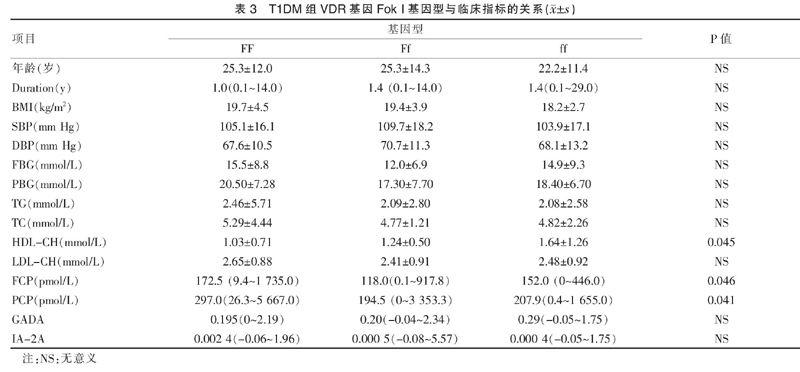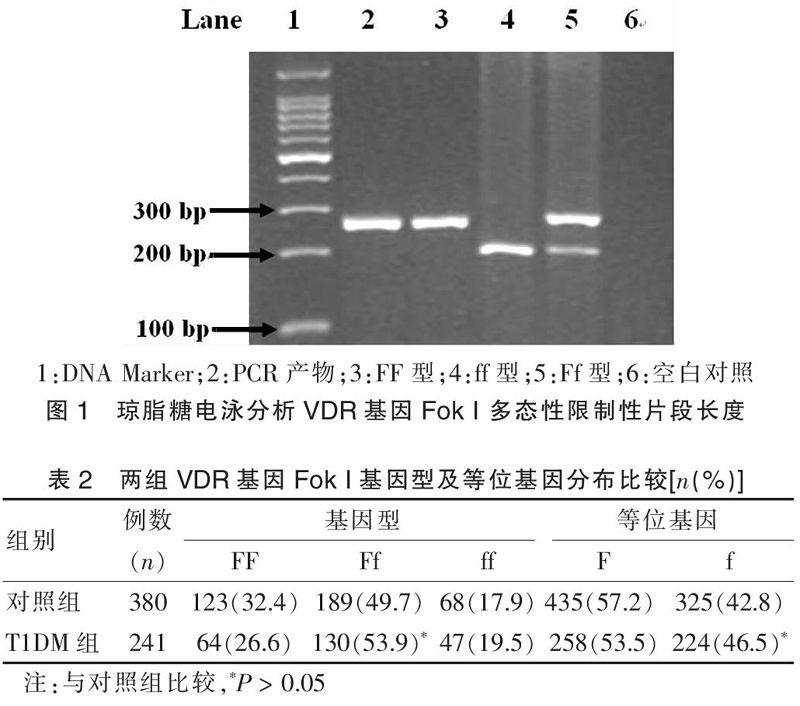维生素D受体基因Fok I多态性与1型糖尿病的相关性研究
2012-09-03杜弢廖岚李万根周智广
杜弢 廖岚 李万根 周智广



[摘要] 目的 探讨维生素D受体(VDR)基因Fok I位点多态性与1型糖尿病(T1DM)的关系。 方法 研究纳入T1DM患者241例和正常对照组380例。VDR基因Fok I位点基因型采用聚合酶链反应-限制性片断长度多态(PCR-RFLP)法检测。 结果 T1DM组VDR基因Fok I基因型分布和F/f等位基因频率与对照组比较,两者间的差异无统计学意义(P > 0.05)。在T1DM组中,Ff基因型组与ff基因型组的空腹-C肽(FCP)和餐后C-肽(PCP)均低于FF基因型组,差异具有统计学意义(P < 0.05)。 结论 VDR基因Fok I多态性与T1DM遗传易感性不相关。T1DM患者中ff基因型与Ff基因型组FCP和PCP呈低水平,提示VDR 基因Fok I基因型可能与胰岛细胞功能相关。
[关键词] 1型糖尿病;维生素D受体基因;多态性;相关性
[中图分类号] R587.1[文献标识码] A[文章编号] 1674-4721(2012)07(c)-0005-03
Association study between the VDR gene Fok I polymorphism and type 1 diabetes
DU Tao1 LIAO Lan2 LI Wangen1 ZHOU Zhiguang3▲
1.Department of Endocrinology, the Second Affiliated Hospital of Guangzhou Medical University, Guangdong Province, Guangzhou 510260, China; 2.Department of Endocrinology, the Xiangya Hospital of Central South University, Hunan Province, Changsha 410008, China; 3.Institute of Metabolism and Endocrinology, the Second Xiangya Hospital of Central South University, Hunan Province, Changsha 410011, China
[Abstract] Objective To explore the association between the VDR gene Fok I polymorphism and type 1 diabetes (T1DM). Methods Two hundred and forty-one T1DM patients and 380 healthy subjects were recruited in the research. Length polymorphism polymerase chain reaction (RFLP-PCR) was performed to identify VDR gene Fok I genotypes. Results No differences were observed between T1DM and controls in VDR Fok I genotype distribution and allele frequencies (P > 0.05). In T1DM group, however, lower levels of fasting C-peptide (FCP) and postprandial C-peptide (PCP) were found in Ff and ff genotypes than FF genotype, the differences were statistical significance (P < 0.05). Conclusion There is no association between the VDR gene Fok I genotype and T1DM. VDR gene Fok I Ff and ff genotypes showe lower FCP and PCP levels, which suggest the VDR gene Fok I genotype is associated with islet cell function in T1DM.
[Key words] Type 1 diabetes; VDR gene; Polymorphism; Association study
1型糖尿病(T1DM)屬自身免疫性疾病,以T淋巴细胞免疫介导的胰岛B细胞功能破坏为特征[1]。T1DM发病机制复杂,为遗传因素和环境因素交互作用的结果。研究发现维生素D受体(VDR)与维生素D复合物后可抑制T细胞活性[2],VDR基因多态性可能与其与复合物结合能力相关,进而影响T细胞介导的免疫调节作用。目前国外已有研究报道维生素D受体基因Fok I多态性与T1DM易感性的关系,但结论不一致[3-10]。本研究通过分析380例正常对照者和241例T1DM患者VDR基因Fok I多态性分布特点,探讨VDR 基因Fok I多态性与T1DM易感性及胰岛细胞功能的关系。
1 资料与方法
1.1 一般资料
1.1.1 T1DM组入组条件:符合1999年世界卫生组织(WHO)糖尿病诊断和分型标准,患者起病6个月内出现自发酮症或酮症酸中毒,GADA≥0.05,排除继发性糖尿病。共纳入患者241例,其中,男性133例,女性108例,平均年龄(24.7±13.2)岁。
1.1.2 正常对照组入组条件:经检查体格健康,且经75 g口服葡萄糖耐量试验(OGTT)检测为正常糖耐量者,并排除高血压、冠心病及肾病等内分泌代谢性疾病病史,且均无糖尿病家族史。共纳入对照者380例,其中,男261例,女119例,平均年龄(61.4±9.8)岁。
以上入选对象均为中国湖南地区汉族彼此间无亲缘关系的人群,入组时间为2005年1月~2008年2月。
1.2 研究对象临床基本资料和血清生化检测
对所有研究对象进行身高、体重、收缩压(SBP)及舒张压(DBP)测量,并计算体重指数(BMI)。受试者进行OGTT时于0及120 min取血,采用葡萄糖氧化酶法测血浆葡萄糖。采用放射免疫法测定血清C肽(三V公司放免试剂盒,XH-6010型x放射免疫计数仪),批内和批间变异系数分别为4.8%和8.9%。放射配体法检测GADA,敏感性和特异性分别为82%和98%。
1.3 VDR基因Fok I多态位点基因型的检测
采用常规苯酚-氯仿法提取外周血基因组DNA,用聚合酶链反应-限制性片断长度多态性(PCR-RFLP)方法检测多态位点基因型。以100 ng DNA为模板在20 μL体系内进行PCR扩增(Gene Amp PCR System 9700,Applied Biosystem,美国),引物序列F:5′-AGC TGG CCC TGG CAC TGA CTC TTG CTC T-3′;R:5′-ATG GAA ACA CCT TGC TTC TTC TCC CTC-3′。PCR反应条件:94℃预变性5 min;后进入循环,94℃变性45 s,60℃退火45 s,72℃延伸1 min,共30个循环;最后72℃终末延伸5 min。PCR产物经2.0%琼脂糖凝胶电泳确认扩增结果后,进行Fok I限制性核酸内切酶 (NEB公司,美国)水解,VDR基因PCR产物37℃酶切过夜。酶解产物经2.5%琼脂糖凝胶电泳(110 V,45 min),以Goldview核酸染料染色,Gel Doc 2000凝胶成像仪下分析PCR产物以及酶切PCR产物,确定样本基因型。
1.4 统计学分析
统计分析用SPSS 13.0软件包完成。基因型分布作Hardy-Weinberg 吻合度检验;组间计数资料比较采用χ2检验;计量资料的两组间比较采用独立样本的t检验,多组间计量资料样本均数比较采用单因素方差(ANOVA)分析;非正态分布的计量资料以中位数及范围表示,组间比较采用非参数检验。所有检验水准P值均为0.05。
2 结果
2.1 研究对象一般临床基本特征
T1DM组与正常对照组在性别比例、体重指数(BMI)、收缩压(SBP)、舒张压(DBP)间的差异无统计学意义(P > 0.05)。T1DM组年龄、空腹血糖(FBG)、餐后血糖(PBG)水平均高于正常对照组,差异具有统计学意义(P < 0.05)(表1)。
2.2 VDR基因Fok I多态性限制性片段长度多态性(RFLP)分析
限制性内切酶Fok I酶切VDR基因的PCR扩增产物后,进行琼脂糖电泳,使用凝胶成像系统分析观察条带。FF型纯合子不含Fok I酶识别位点,显示为1条265 bp片段;ff型纯合子具有Fok I酶识别位点,显示为2条分别为69 bp和196 bp 的片段;杂合子Ff型的酶切产物则出现3个片段:69 bp、196 bp和265 bp(图1)。
2.3 基因型及等位基因频率的分布情况
T1DM和对照组的Fok I基因型分布均符合Hardy-Weinberg平衡。与对照组比较,T1DM组VDR基因Fok I基因型分布和等位基因频率的差异无统计学意义(P > 0.05)(表2)。
2.4 T1DM组VDR基因Fok I基因型与临床指标的关系
比较T1DM中VDR基因Fok I各基因型患者间的临床指标差异,结果显示Ff基因型组与ff基因型组的空腹C-肽(FCP)、餐后C-肽(PCP)均低于FF基因型组,差异具有统计学意义(P < 0.05)(表3)。
3 讨论
目前VDR基因Fok I多态性与T1DM易感性的相关研究结果并不一致。这些研究包括来自希腊[4]、日本[5]、荷兰[6]、南斯拉夫[7]、西班牙[8-9]、意大利[10]等国的研究。导致这些研究结果的不一致性的因素部分是由于有些研究的樣本数过小;出现较多阳性研究结果报道的可能解释是出版偏倚[8]。本研究显示VDR基因Fok I基因多态性与T1DM易感性不相关,研究结果与罗马尼亚、芬兰、挪威、美国、英国、土耳其、德国、葡萄牙等国家学者研究结果相同[3,11-15]。
T1DM是多基因遗传病,其遗传病因研究的标志物如其他多基因疾病中遗传标志物一样,由于不同研究对象来自不同的种族和地域,其结果往往不同[16]。例如,VDR基因Fok I多态性与西班牙人群T1DM易感性的关联基因随着西班牙地区地理位置不同而变化,在西班牙地中海地区,T1DM患者中转录活性更强的VDR Fok I FF基因型比例增加,而在西班牙纳瓦拉区域的T1DM患者中则是转录活性较弱的ff基因型降低[8]。一项以3 000例芬兰人作为观察对象的较大样本的病例对照研究发现,芬兰人群中VDR基因Fok I SNPs与T1DM易感性不相关[13]。Nejentsev S等[12]的大样本研究中纳入对象来自不同地区和国家,该研究结果也否认了VDR基因Fok I基因多态性与T1DM易感性的关联。但这些研究中T1DM患者可能包含了部分LADA患者,这使得研究人群的存在异质性,可能是造成各研究结果不一致的一个原因。在本研究中,T1DM不包括LADA患者,因而本研究结果能够更好的反映出T1DM患者VDR基因Fok I基因型特征。
本研究发现ff基因型组与Ff基因型组的FCP和PCP水平显著低于FF基因型组,表明ff基因型组与Ff基因型组患者胰岛细胞功能更差,提示VDR基因Fok I基因型可能与胰岛素分泌相关,这个结果与Mory DB等[17]和Ogunkolade BW等[18]的研究相符。Mory DB等[17]研究发现Ff基因型和ff基因型患者残存的胰岛功能较FF基因型低;Ogunkolade BW等研究亦表明VDR基因型Fok I基因与胰岛素分泌能力相关,VDR基因型是VDR mRNA和VDR蛋白水平的重要决定因素之一,Fok I多态性影响VDR mRNA水平。同时有研究发现VDR基因Fok I基因多态性可能干扰VDR异聚体与视黄酸X受体形成效应复合物[19],VDR ff基因型转录活性降低,VDR mRNA水平降低,引起胰岛素分泌能力降低,C肽分泌减少。上述研究提示,T1DM患者中VDR ff基因型组与Ff基因型与胰岛细胞功能负相关。
綜上所述,本研究结果显示VDR基因Fok I多态性与T1DM遗传易感性不相关;T1DM患者中ff基因型与Ff基因型的FCP和PCP水平显著低于FF基因型患者,提示T1DM患者VDR基因Fok I基因型与胰岛细胞功能相关。
[参考文献]
[1]Bach JF. Insulin-dependent diabetes mellitus as an autoimmune disease[J]. Endocr Rev,1994,15(4):516-542.
[2]Bhalla AK,Amento EP,Serog B,et al. 1,25-Dihydroxyvitamin D3 inhibits antigen-induced T cell activation[J]. J Immunol,1984,133(4):1748-1754.
[3]Machael A,Pani MA,Knapp M,et al. Vitamin D receptor allele combinations influence genetic susceptibility to type 1 diabetes in Germans[J]. Diabetes,2000,49(3):504-507.
[4]Panierakis C,Goulielmos G,Mamoulakis D,et al. Vitamin D receptor gene polymorphisms and susceptibility to type 1 diabetes in Crete,Greece[J]. Clin Immunol,2009,133(2):276-281.
[5]Yokota I,Satomura S,Kitamura S,et al. Association between vitamin D receptor genotype and age of onset in juvenile Japanese patients with type 1 diabetes[J]. Diabetes Care,2002,25(7):1244.
[6]Koeleman BP,Valdigem G,Eerligh P,et al. Seasonality of birth in patients with type 1 diabetes[J]. Lancet,2002,359(9313):1246-1247.
[7]Zemunik T,Skrabic V,Boraska V,et al. Fok I polymorphism,vitamin D receptor,and interleukin-1 receptor haplotypes are associated with type 1 diabetes in the Dalmatian population[J]. J Mol Diagn,2005,7(5):600-604.
[8]Audi L,Marti G,Esteban C,et al. VDR gene polymorphism at exon 2 start codon (Fok I) may have influenced Type 1 diabetes mellitus susceptibility in two Spanish populations[J]. Diabet Med,2004,21(4):393-394.
[9]San-Pedro JI,Bilbao JR,Perez de Nanclares G,et al. Heterogeneity of vitamin D receptor gene association with celiac disease and type 1 diabetes mellitus[J]. Autoimmunity,2005,38(6):439-444.
[10]Capoluongo E,Pitocco D,Concolino P,et al. Slight association between type 1 diabetes and "ff" VDR Fok I genotype in patients from the Italian Lazio Region. Lack of association with diabetes complications[J]. Clin Biochem,2006,39(9):888-892.
[11]Guja C,Marshall S,Welsh K,et al. The study of CTLA-4 and vitamin D receptor polymorphisms in the Romanian type 1 diabetes population[J]. J Cell Mol Med,2002,6(1):75-81.
[12]Nejentsev S,Cooper JD,Godfrey L,et al. Analysis of the vitamin D receptor gene sequence variants in type 1 diabetes[J]. Diabetes,2004,53(10):2709-2712.
[13]Turpeinen H,Hermann R,Vaara S,et al. Vitamin D receptor polymorphisms: no association with type 1 diabetes in the Finnish population[J]. Eur J Endocrinol,2003,149(6):591-596.
[14]Gogas Yavuz D,Keskin L,Klylcl S,et al. Vitamin D receptor gene BsmI,FokI,ApaI,TaqI polymorphisms and bone mineral density in a group of Turkish type 1 diabetic patients[J]. Acta Diabetol,2011,48(4):329-336.
[15]Lemos MC,Fagulha A,Coutinho E,et al. Lack of association of vitamin D receptor gene polymorphisms with susceptibility to type 1 diabetes mellitus in the Portuguese population[J]. Hum Immunol,2008,69(2):134-138. [16]Guo SW,Magnuson VL,Schiller JJ,et al. Meta-analysis of vitamin D receptor polymorphisms and type 1 diabetes: a HuGE review of genetic association studies[J]. Am J Epidemiol,2006,164(8):711-724.
[17]Mory DB,Rocco ER,Miranda WL,et al. Prevalence of vitamin D receptor gene polymorphisms FokI and BsmI in Brazilian individuals with type 1 diabetes and their relation to beta-cell autoimmunity and to remaining beta-cell function[J]. Hum Immunol,2009,70(6):447-451. [18]Ogunkolade BW,Boucher BJ,Prahl JM,et al. Vitamin D receptor (VDR) mRNA and VDR protein levels in relation to vitamin D status,insulin secretory capacity,and VDR genotype in Bangladeshi Asians[J]. Diabetes,2002,51(7):2294-2300.
[19]Haussler MR,Whitfield GK,Haussler CA,et al. The nuclear vitamin D receptor:biological and molecular regulatory properties revealed[J]. J Bone Miner Res,1998,3(3):325-349.
(收稿日期:2012-07-04本文編辑:林利利)
